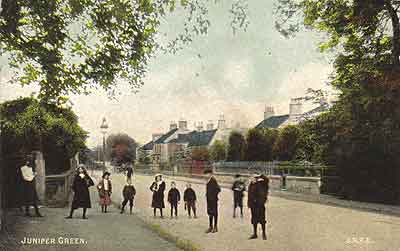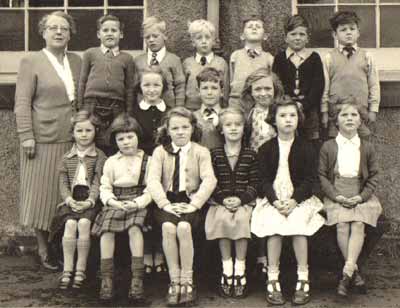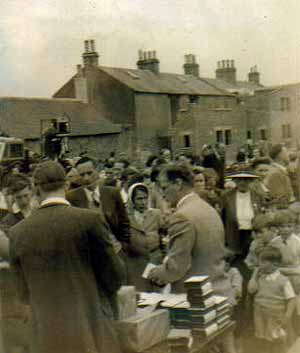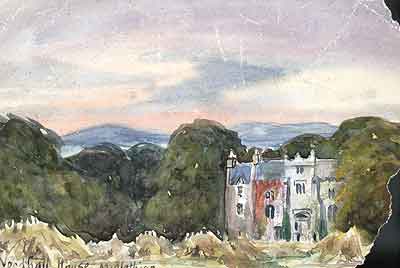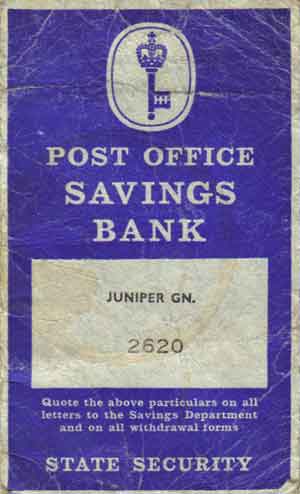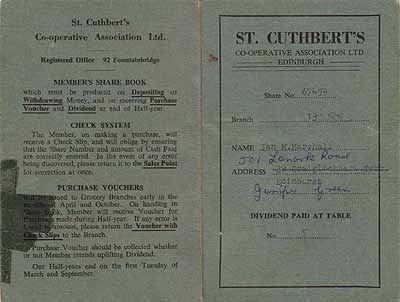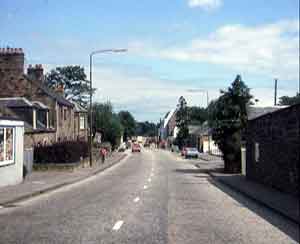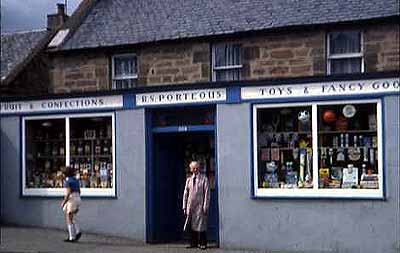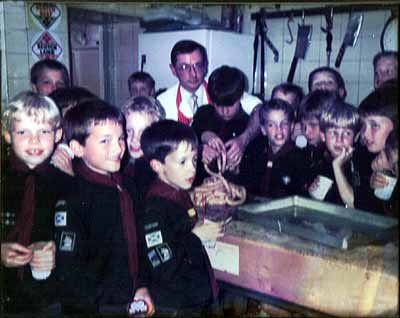Memories of Juniper Green
Ian Marshall remembers...
In a conversation with David Geary on Wednesday 11th October 2006 Ian Marshall recalls the shops, businesses and other features of Juniper Green over the last fifty years.
I moved with my family to Baberton Crescent, Juniper Green from Sighthill, when I was four, in 1951. My parents were Willie and Dolly Marshall. When my father died in 1971 I moved to Juniper Grove and lived with my mother for two years before marrying Eileen, and moving to Craiglockhart. After a few years there we moved back to Juniper Green, to 501 Lanark Road, with my sons David and Ewan.
School
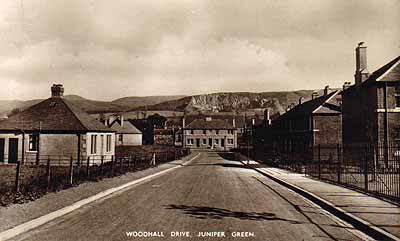
© Nutsend Productions
An early view of a developing Woodhall Drive with the Torphin quarry in the background
My earliest memories of Juniper Green would be when I was walking along Baberton Crescent to the old school buildings. I got to know other new entrants who joined at the same time. I remember playing in a small field on the south side of Woodhall Terrace at the corner with Woodhall Drive. it was like an adventure playground to us. Later it was developed with four bungalows.
I started at Juniper Green School in 1953 at age five and was there until I was around10 years old. My teacher at Juniper Green was Miss Fraser, as seen in a photograph of my class taken in the mid fifties.
1953 coronation
One thing that was very memorable at that time was going to see the Coronation of the Queen in 1953. Three groups from school watched it on televisions owned by childrens' parents in the village. I went round to the house of Mr Keddie, the builder, in Woodhall Drive to see what I recall was a very large TV set with a very small screen! I was a friend of his son Andrew. The black and white pictures were not very clear. Afterwards we were all presented with a little model of the Queen's carriage and horses, a china mug and a tube of Merrils. They were a hard boiled toffee sweet with a soft caramel centre in a tube. I don't recall any Coronation decorations around the village.
Gas street lighting
I can remember cast iron street lamps that were lit by gas. They had a square glazed top that contained a white filament which glowed brightly when lit. If one of the filaments was discarded, following being changed from time to time, and it was touched it instantly went to powder.
We roamed the countryside
Playing was a great joy in these days and we roamed the countryside as youngsters. My best friends were James Gerard, who lived in Lanark Road, Ian McFarlane who lived in Belmont Avenue, and Kenneth Russell who lived in St Leonards, at the end of Foulis Crescent. The wooded valley of the Water of Leith and the Pentland Hills were our playground, as were the fields and woods round Baberton Golf Course, now the site of Baberton Mains. We used to go hunting for golf balls in the field to the right of the drive to Baberton House. The family who lived there then were the Cullens. This was also before the massive Wester Hailes Housing area was built on what was then Wester Hailes farm. One of my Baberton Crescent neighbours, Margery Mather, had an uncle and aunt, the Smith family, who ran Wester Hailes farm until it was compulsorily purchased by Edinburgh Council for the housing development. I also had a friend, Alec Henderson whose parents ran a smallholding on the right hand side of Wester Hailes Road. It ran from Gillespie Crossroads to Sighthill via Fernieflats. In those days it was a country road.The mills and the Water of Leith
In those days we swam in the Water of Leith, and caught fish there with hooks and worms. We also used to visit the paper mills and collect their scrap paper for drawing on. The streets used to be covered in the dried esparto grass they used for manufacturing the paper. It was blown off the lorries that delivered it.
Playing on the railway
I remember particularly the trains coming out on the railway line from town, now the route of the walkway, through Colinton and Juniper Green, to Balerno. They were only goods trains, mainly I think to take coal to Saunders coal yard in Balerno and other goods to and from the various mills along the river valley. The trains were quite frequent but not too fast. The line was not fenced off so, if you happened to be playing on or near the line, good hearing was essential to avoid danger! I clearly remember the station at Juniper Green, where the Splash warehouse is now located, with passenger coaches parked in sidings there. We used the luggage netting above the seats in the compartments as hammocks.
When passenger trains ran some years before my time, a system was in place that alerted the golfers at the bar in Baberton Golf Club when the train was leaving Balerno for Edinburgh, giving them enough time for drinks to be finished before walking to Juniper Green station to catch the train for town!
One last special passenger trip occurred, I think in the early sixties before the line was finally closed. I recall this was round the Pentlands, up the Balerno Branch line to Newmills where there was a link over to the Glasgow Central line, then to Carstairs and back to Edinburgh. This was probably at around the time of the Beeching rail closures.
South side of Lanark Road
The street plan of Juniper Green brings back many memories. Travelling west on the south side of Lanark Road from Gillespie Crossroads, the first business is Tanners Pub, which it became at least 15 years ago. I first remember it as the Pentland Arms, locally known as Davie Simpson's who was the owner in the fifties. It was also nicknamed "the bottom shop" to distinguish it from "the middle shop" (the Railway Inn) and "the top shop" (the Kinleith Arms).
Moving west, and above what is now the City Bypass, were the Fairy Gardens, a shrubbery with a path, on which were seats where people sat and enjoyed fine views south over the valley of the river and Inglis Grain Mill to Bonaly, the Quarry and the Pentland Hills. Beyond that towards the Village was Woodhall Nursery. This was an Adult Education Centre where bedding plants and vegetables were grown for sale to the public. It is now Lorimer Court. Next to that is Southernwood, an impressive house that was the surgery for Doctors Ross and Sneddon.
To the west again was Torduff, a very imposing house, designed by the famous Architect, Sir Robert Lorimer, in which Mr Bruce of Kinleith Mill lived (see below). Torduff, significantly extended and adapted many years ago, is now Lorimer House Nursing Home.
St Margarets Church, close to the centre of Juniper Green Village, was demolished in the early seventies. It was, I remember, a beautiful building inside with a very rustic feeling about it. The congregations of St Margarets Church and the other church in the village, then St Andrews, and now Juniper Green Parish Church, would join together on occasions, when the minister of one or other was on holiday. I recall that relations between the two congregations were polite, but not particularly cordial!
Between St Margarets Church and Juniper Green Post Office was the main access to Woodhall Paper Mill over the twisting roadway down to the river valley. This would also have been access to Juniper Green Station and the pedestrian route to the quarry which lies up beyond Pass's farm on the south side of the Water of Leith. The quarrymen were a familiar sight, walking up the narrow path beyond the farm, in single file, each morning and returning late afternoon. The sound of loud explosions from the quarry was frequently heard during working days. The path to Pass's farm also led to Woodhall House, which in the fifties was a Jesuit College. Its woods and grounds were forbidding, a place in which, as children, we didn't dare to trespass. When it closed as a seminary it was converted to flats.
Juniper Green Post Office lies to the west of Station Brae. It has always been a Post Office since I came to Juniper Green. In those early days the Postmaster was a Mr Scott who, with assistance from Mrs Scott, seemed to work very long hours. His thick spectacles gave him a very distinctive appearance.
Beyond are the public toilets and a cottage, then, where Al Borgo and the Pentland Fry are now situated, was a shop called Rankin's that sold sweets and cigarettes. In the fifties five Woodbine cigarettes would cost about 10d - that is pence in old money (if you were asked who you were buying them for you would say your mother!). Mrs Rankin and her daughter ran it. This shop subsequently became a fruiterer, run by Ruby Bush. Beyond a terraced cottage or two was the Butchers shop called Gillon and Roberts.
Next door, going west, on the site of the existing block of flats, was an Esso filling station, run by a South African and his wife. In the early sixties I worked at the pumps on Saturday afternoons and then as a barman in the Railway Inn on Saturday nights.
Beyond the large house (the Dower House) and its large garden was Allisons Bakery (more recently an estate agent's). Prior to the establishment of the nearby Swallow Chinese Carry-Out that property was just a cottage.
The Fishmongers shop, located just off Lanark Road on a pedestrian route to Woodhall Paper Mill, has been there for many years.
Dawn's Cafe used to be occupied by Colinton Arts and Crafts. A friend of mine, Billie Allan, worked there some years ago. An interesting aspect of their trade at that time was the sale of draught sherry to customers who got their own bottles filled up at very reasonable prices!
Many more years ago Mr Dea ran a business repairing bicycles from his house next door. His sister Charlotte Dea still lives in the village. She was a great friend of my late mother.
The hairdresser shop at 579 Lanark Road was preceded by Dougie Stuart's Newspaper and general shop, and before him the same type of business was called Gilchrists.
The last business in Juniper Green on the south side of Lanark Road, going west towards the old Edinburgh city boundary, was originally, for many years, "the Store", which was the local name for the St Cuthbert's Co-operative Association. Members received a Store Book, in which points for money spent were entered, leading to a dividend being paid to members each year around Christmas time. I still remember our family number that had to be given when buying any goods. The "divvy" was collected at the St Cuthbert's head office in Fountainbridge. There were two sections to the Store. One was the grocery side and the other was the butchers, called the fleshing section. I recall that the counter in it was on the left and along the right hand side various skinned carcasses hung from butchers' hooks, beneath which blood drips were mopped up by a liberal spreading of sawdust. Charming!
Since the early sixties the store units have been a variety of businesses. I think the first change of use was to the Brown Derby Restaurant, which was owned by a city councillor called Tom Pontin. It didn't last very long but it was beautifully fitted out and the food was good. However it was very large, a bit like a barn. You wouldn't have been attracted there for an intimate meal. It then became an office and workshop occupied by McMurray Signs. The property then became occupied by the current users, Margaret Best, Optometrists, and the Scottish Hockey Association offices.
North side of Lanark road
Turning to the north side of Lanark Road, travelling west from Gillespie Crossroads, Juniper Green Bowling Club stood in the sixties on the site which now forms part of the City Bypass. It had the reputation of being the finest bowling green in Edinburgh, next to which was a small clubhouse. Next to that was the Manse for St Andrew's (now Juniper Green) Church. Dr Malcolm was the minister in the fifties and sixties. Dr and Mrs Malcolm's family were Robert, Christine, Sheila and Peter, all great friends. The Malcolms were succeeded by the Camerons, and, since 2001, by Jim and Jean Dewar and family. Firknowe was the Manse for St Ninian's Church in Wester Hailes.
Near the Lanark Road junction with Woodhall Drive, the Bield was Dr Sellars' surgery and house in the fifties. This house was subsequently occupied by Professor and Lady Sir Michael Woodruff and family. He made history, I think, by being the first person to undertake a kidney transplant in the UK, in the nineteen sixties.
On to the shops again. Forsyth's fruit shop was at 534 until at least the mid-fifties. Mr Forsyth had a pronounced stoop. I remember large boxes of potatoes, turnips and carrots at the side of the shop. It then became the Candy Box, a confectioners, cafe and ice cream shop. Next door, on the corner with Baberton Avenue, was Scotts (Bill) the Grocer, subsequently run by Peter Smith.
On the west side of Baberton Avenue, going west on the Lanark Road, was Montpelier a large private house behind a stone wall. I think a family by the name of Lamont lived there in the nineteen fifties. It was demolished in the nineteen sixties to become the Royal Bank of Scotland.
Beyond is the "Middle Shop", the Railway Inn, very much a village pub over the years. John Keilty and his wife took it over in the early sixties. A cosy lounge bar to the left and a busy public bar to the right. Darts and dominoes were very popular - Jimmy Crabbe, Peter Smith, wee Bobby, Colin Stewart, Ronnie Ireland, Jimmy Maxwell, Donald and many others were regulars. I spent many nights behind the bar (and some in front of it) feeling very much part of the community. Happy days! John Keilty, the landlord, was succeeded by Laurie and Jess Morton, and one or two others until Ally Love took over and changed the layout to provide a very well run single lounge bar serving excellent bar lunches. This arrangement continues until the present day. Next door in those early days was a Chemist shop.
Just up from there was a terraced house that in the fifties and early sixties had been the National Commercial Bank and manager's house. It was closed in the sixties, and, coincidentally, I provided a valuation of the property for its purchase from the bank by the then manager, a Mr Stewart. He and his family, and his dogs, were well known in the village.
The next shop, moving west, was a general hardware store run by Bert Porteous and his family. It had a "bungalow" style glazed projection out from the stone front wall of the house, now removed and restored to its original style as a house. Bert ran the shop with his wife, sister Ella, and daughter. The range of things to purchase was extreme! Tools, toys, stationery, fishing nets, all sorts of things. All the Porteous family were most friendly, a great asset to the village. Whatever was purchased, even if only two items, Bert noted all the prices on a small piece of paper with a small pencil, quickly added them up, then declared the total with a flourish!
Beyond a few more houses, was Scotts, the Butchers and Grocers. This was run by Mike Scott, who still lives in a house to the rear of the existing business. The business was taken over some years ago by Jimmy Watters, whose sausages and haggis won many awards, including the Best in Scotland one year.
Next door was Bryce's Garage, also a petrol filling station, I think selling "National" Petrol. When I was a youngster the craze was to obtain free badges from filling stations, much prized possessions. I used to visit there as often as I dared and ask for such badges, to which the first response would be "Are you buying any petrol?". "No" I would say. "Well you're not getting any badges then," they would reply. However, somehow, one precious shiny enamel badge might be found in a box in the office and handed over, making the visit worthwhile! The site of this garage became Juniper Green Bowling Club at the rear in the sixties, and at the front Lowfreeze (later Iceland).
To the west, next door, is "the Top Shop", the Kinleith Arms public house, of which I was only an occasional customer.
Beyond Belmont Avenue was a shop/office occupied by Ferguson's the Painter. My mother was one of his customers, and he was certainly there until the 1960's. It is now a Beauty Salon. Then, finally is the Business Centre, which contains a variety of workshops and offices. Not much further on is the old city boundary, then the start of Currie.
Baberton Avenue
There was one further shop that I have not mentioned yet. That was Miss Benson's sweet shop in Baberton Avenue, in a building that once stood where the entrance now is to Baberton Park. I can remember going there in the very early fifties looking for bubble gum, which I wasn't allowed to have. Like a Dainty, or a giant gobstopper, it cost a penny in those days of rationing, but that day Miss Benson didn't have any bubble gum in stock. However, some days later with my Mum we went into the shop to buy some other sweets that were allowed (probably liquorice laces or pan drops) and Miss Benson immediately announced with great satisfaction that my bubble gum was now in. I was caught! Your sins will always find you out.
Further up Baberton Avenue, on the right, was a joinery workshop owned by Mr Howitt. He used to make sturdy wooden sledges for us, and give us bits and pieces of wood to make hutches for our rabbits or cages for our white pet mice. He would also provide as much sawdust as we required for bedding for our pets.
At the very top of Baberton Avenue, on the left beyond the tennis courts and opposite the Village Hall was a building containing the School Meals Kitchens, which was the centre of production for school meals. My memory of that was the dreadful smell of cooked cabbage and mince.
The buses
In those days Juniper Green was the end of the line for the Corporation buses. The 44, 45 and 46, and at one time the "New 8" all came up Baberton Avenue, along Belmont Road and round to their terminus in a lay by, facing back into town, outside Scotts the Butcher and Grocer. The only ones that went on up the Lanark Road were the green SMT buses to Balerno.
Village Hall and Park
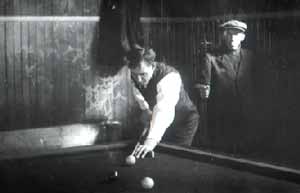
The snooker and billiard tables in the Village Hall gave hours of fun to many in the community
In those early days the Village Hall was a very popular meeting place for youngsters and others slightly older. I used to go there some winter evenings and Saturday afternoons to play snooker. Others attended the rifle shooting club in the .22 range that ran along the rear of the hall. Sometimes there was even a card school, when pennies, thruppenies, tanners, bobs, and sometimes even florins and half crowns might be won or lost, depending whether you held, twisted or went bust in the game of pontoon, or kept your nerve in a game of three card brag. If you wanted a misspent youth it was there to be found in Juniper Green!
The village Park, called Bloomiehall, was also a popular place to visit. The swings used to be at the Village Hall end, behind various old farm buildings in which the grass cutting machinery was stored. I remember the "Parkie" lived in the cottage there that was surrounded by trees. I used to play football there on Sunday afternoons with jerseys for goalposts.
Baberton Golf Club
The other sporting venue close by is Baberton Golf Club which has a history going back to 1893. In those days the first steel-shafted golf clubs were invented by the local blacksmith Thomas Horsburgh and they are still in the clubhouse. He took a patent out on them in 1895 which he renewed annually for around five years but they didn't take off at that time. The shafts were solid and very whippy. It wasn't until the thirties that someone thought of making tubular metal shafts, much stronger, lighter and stiffer. Those took on, but Baberton's place in world golfing history is unique relative to equipment is unique. These original clubs are very valuable now.
Characters
When we played football in the park one of the players, just a wee lad of about 12, was brilliant. He ran rings round us. We said that he would play for Scotland one day. He did! He was Paul Hegarty. He and his brother Kevin, who also made a career playing senior professional football, lived in Woodhall Terrace. His dad in those days was the local postman.

© Royal Commission on the Ancient and Historical Monuments of Scotland. Licensor www.scran.ac.uk
A view of Lorimer House at 491 Lanark Road in Juniper Green
Mr Bruce of Kinleith mill lived in Torduff (now Lorimer house) A charming, amusing and slightly eccentric gentleman, he used to walk past my house on Lanark Road and frequently commented that he was pleased to see that the "religious seagulls were back, sitting on top of the Church belfry". He was also impressed by the red doors of the Railway Inn which were "...just the right colour to warn people not to go in!"

